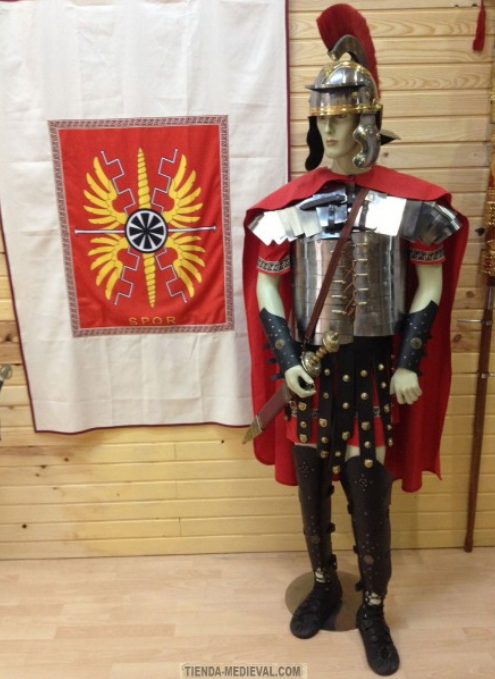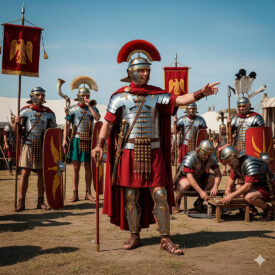When we think of the Roman army, it is almost inevitable that the image of a sturdy legionary, clad in gleaming plated armor, comes to mind. This iconic defensive piece, known today as lorica segmentata, has endured through the centuries as a symbol of Rome’s power and discipline. But what do we really know about this revolutionary armor and its impact on the battlefield? Join us on a journey through time to unravel the secrets of the lorica segmentata, from its mysterious origin to its complex manufacture and the crucial role it played in the Roman military machine.
A Modern Name for an Ancient Engineering Marvel
Curiously, the term “lorica segmentata” is not Roman; it was coined by archaeologists in the 16th century and popularized from the 19th century onward. It is likely that the Romans themselves referred to it simply as “lorica” (breastplate), although its exact name is unknown. This distinction highlights an important point: despite its fame, information from primary sources and complete archaeological finds about this armor are surprisingly scarce.
For a long time it was believed that the lorica segmentata emerged in the mid-1st century AD. However, recent archaeological discoveries at Kalkriese (Germany), the site of Varus’s devastating defeat in AD 9, have revealed that the lorica segmentata was already in use by the end of Augustus’s Principate, pushing its origin back by at least half a century. This links it directly to Augustus’s military reforms to improve the protection and efficiency of his troops. Roman legions used it from the late 1st century BC until the mid-3rd century AD.
Design and Construction: Roman Genius in Iron Plates
The lorica segmentata was a modular breastplate made up of horizontal strips of iron or steel. These strips overlapped and were joined internally by leather straps and, externally, by appliqués and buckles of copper alloy (orichalcum) that held it in place. The lorica segmentata represented a true revolution and a masterpiece of engineering in the legions’ fighting gear.
The design was intended to protect the legionary’s torso from the waist to the neck, including shoulder pieces adapted to cover this vital area. This clever construction provided excellent defense against sword blows and projectiles while offering notable flexibility and range of movement to the soldier. Although it may not seem so, one of its advantages was that it was an armor that could be dismantled easily by releasing the buckles and fastenings, which auto-adjusted with leather strips. Additionally, it stored in a compact space, greatly facilitating transport during long marches.
Evolution Through Time: Types of Lorica Segmentata
Although the basic concept remained the same, the lorica segmentata evolved during its period of use. Three main models have been identified, named after the places of their first archaeological finds. There is a fourth variant whose existence is more debated.
- Kalkriese type: Used from 20 BC to AD 50. The earliest variant, documented at sites like Kalkriese and other Augustan camps. Its use was relatively brief, and its reconstruction still presents challenges due to the scarcity of remains.
- Corbridge type: Used from AD 40 to AD 120. This model, discovered at Corbridge (England) in 1964, was crucial for understanding the armor’s construction. It was characterized by numerous metal hooks and buckles (up to 50) which, while essential, also represented its weakest point.
- Newstead type: Used from AD 120 to AD 250. Developed in the early 2nd century, this variant aimed to be more functional, reducing the number of hooks to 24, making it less prone to breakage. It featured wider shoulders with larger hinges and used hooks instead of buckles for front and back adjustments.
- Alba Iulia type: This possible variant is inferred from sculptural representations in Romania. However, the lack of tangible archaeological evidence leads some historians to consider it more of an artistic license than a real model.
Tactical Advantages and Challenges on the Battlefield
Superior Protection and Flexibility
The lorica segmentata offered clear tactical advantages. Its rigid, overlapping design made it particularly effective against downward sword strikes and provided excellent protection against arrows, darts and javelins. Additionally, its weight, which ranged between 5 and 9 kilograms, was considerably less than that of chain mail (lorica hamata), reducing the legionary’s fatigue during long marches and protracted engagements. This superior protection allowed legionaries to adopt more aggressive stances in close combat. Regarding comfort, it is much more comfortable than many medieval armors produced in later centuries.
The Psychological Impact: A Shining Army
Beyond the practical, the appearance of the lorica segmentata had a significant psychological impact. A Roman army with polished, gleaming armor was a terrifying sight for the enemy, capable of undermining morale even before battle, while reinforcing the esprit de corps of its own troops. Onasander, a Greek military writer, recommended that the battle line shine before the enemy with weapons, helmets and clean, polished armor, which would make the cohorts’ advance appear more dangerous.
Maintenance and Vulnerabilities: The Complex Side of the Armor
However, it was not all advantage. Maintenance of the lorica segmentata was complex and constant. The hooks and buckles of copper alloy were prone to corrosion and wear, requiring frequent repairs. For major repairs, the armor had to be sent to specialized workshops (fabricae) with qualified personnel (custodes armorum), since an ordinary legionary could not carry out all repairs. Another drawback was the vulnerability of certain areas: unlike chain mail, it left the upper parts of the arms and the thighs unprotected. Its discontinuation was not so much due to its effectiveness as to the decline of the Roman legions and the complexity of its large-scale maintenance.
A Universal Use? The Debate over Its Spread in the Empire
Although sculptural representations such as Trajan’s Column show almost all legionaries wearing lorica segmentata, the reality of its widespread use—especially on the Empire’s eastern frontiers—is a matter of debate. Most archaeological finds come from the European frontiers, particularly Britannia and the Germanies. It is argued that eastern climatic conditions would have accelerated corrosion and that chain mail (lorica hamata), being more flexible and easier to repair, was better suited to the type of fighting in that region. Therefore, it is possible that artistic depictions were a stylistic convention to differentiate legionaries from auxiliary troops rather than an exact reflection of equipment in every theater of operations.
The Secret of Roman Mass Production
Production of the lorica segmentata was a large-scale enterprise. The Roman state assumed responsibility for supplying weapons and armor, requiring enormous infrastructure from mining to smithing. Modern research has revealed that the iron used was of high purity and that the consistency in plate thickness (around 1.0 mm) suggests the use of mechanical means, such as rollers, to produce metal sheets of high precision efficiently—a technological feat for the time. Legionary workshops (fabricae) played a vital role, standardizing parts in a limited number of sizes for mass, functional production.
Beyond Defense: Treatments, Appearance and Legacy
Keeping the Shine: Polishing, Oiling and Bluing
Maintenance was an essential routine. To prevent corrosion and enhance appearance, armor was polished with abrasives, oiled, and heat-treated to create a protective oxide layer (bluing). Occasionally, tin was applied to prevent oxidation or thin sheets of precious metals were used as a status indicator.
Lorica Segmentata for Children: Emulating the Heroes
Roman children also often wore lorica segmentatas, especially the sons of centurions and legionaries. It was a way to emulate their fathers, whom they saw as heroes. Proud parents encouraged their children to resemble them, instilling from an early age the ideal of the Roman soldier.

A Legacy of Iron and Glory
The lorica segmentata, together with other types of armor such as the lorica hamata and lorica squamata, left an invaluable legacy. Its study has provided deep insight into Roman military technology. It was a dynamic process driven by battlefield needs and the Empire’s capacity for innovation. The lorica segmentata testifies to the sophistication achieved by Roman armorers—an armor that, a thousand years after the fall of Rome, would still inspire similar designs in the Renaissance.
Its shine on the battlefield not only protected the legionary but projected Rome’s majesty and power, making it a cornerstone of military history and an enduring symbol. If you are fascinated by Rome’s history and wish to own a piece of this legacy, you can explore various replicas and armors inspired by this glorious era.
SEE MORE LORICAS SEGMENTATA | SEE OTHER PERIOD BREASTPLATES | SEE VARIOUS ARMOR PIECES













